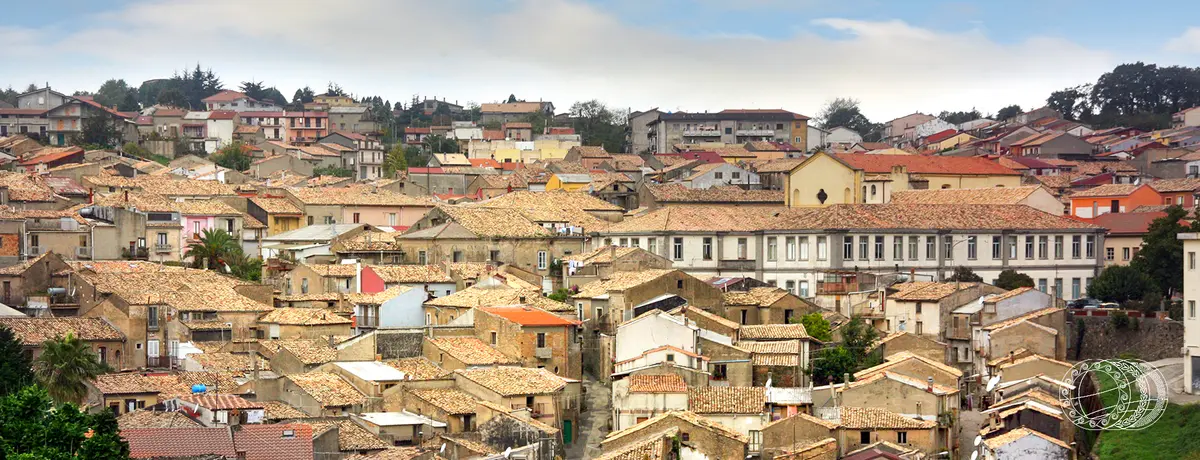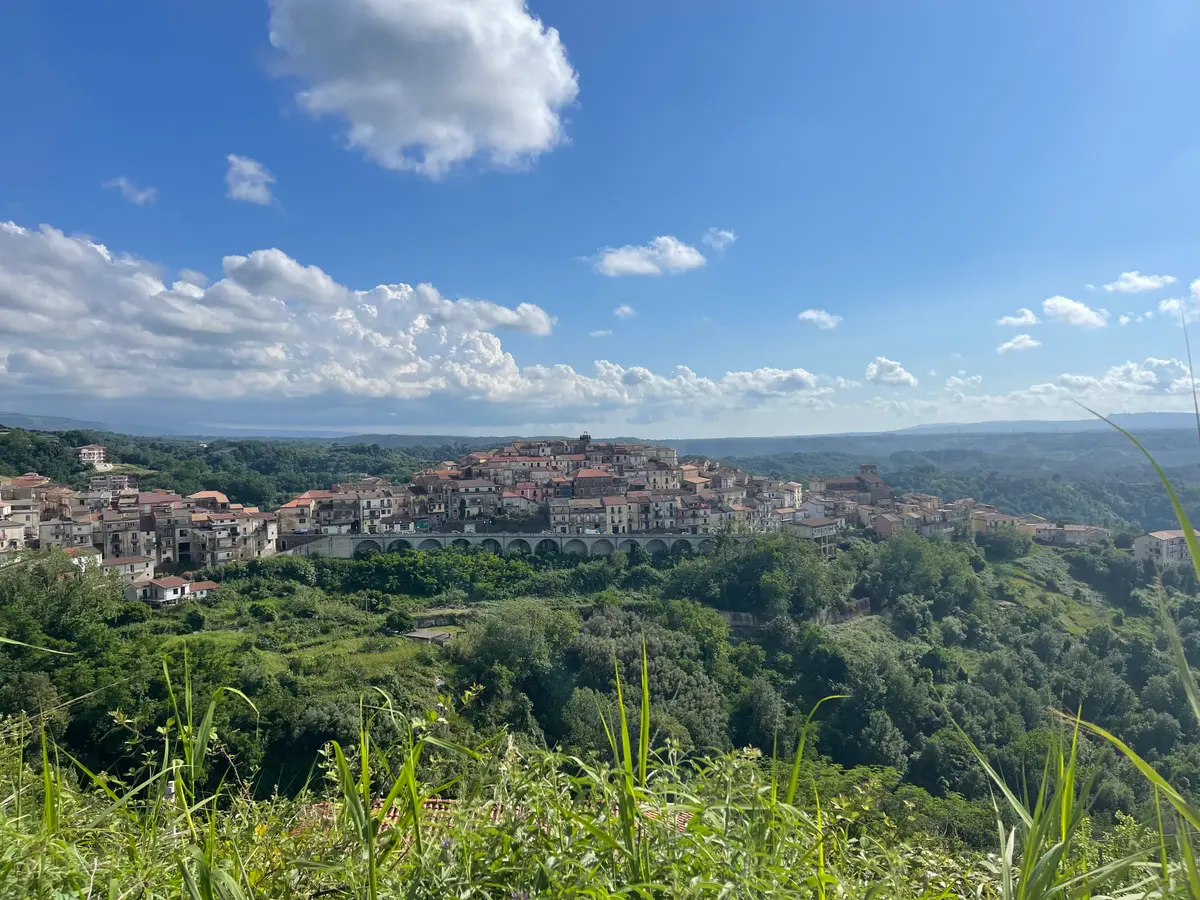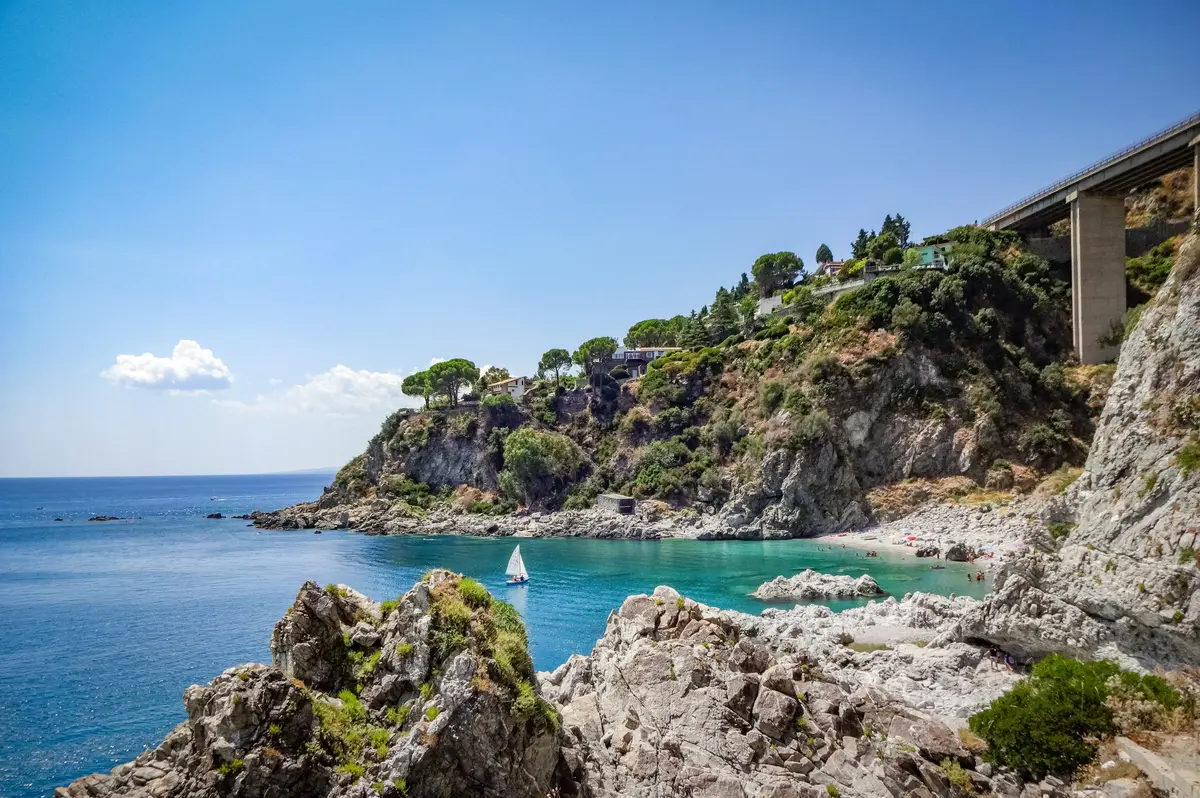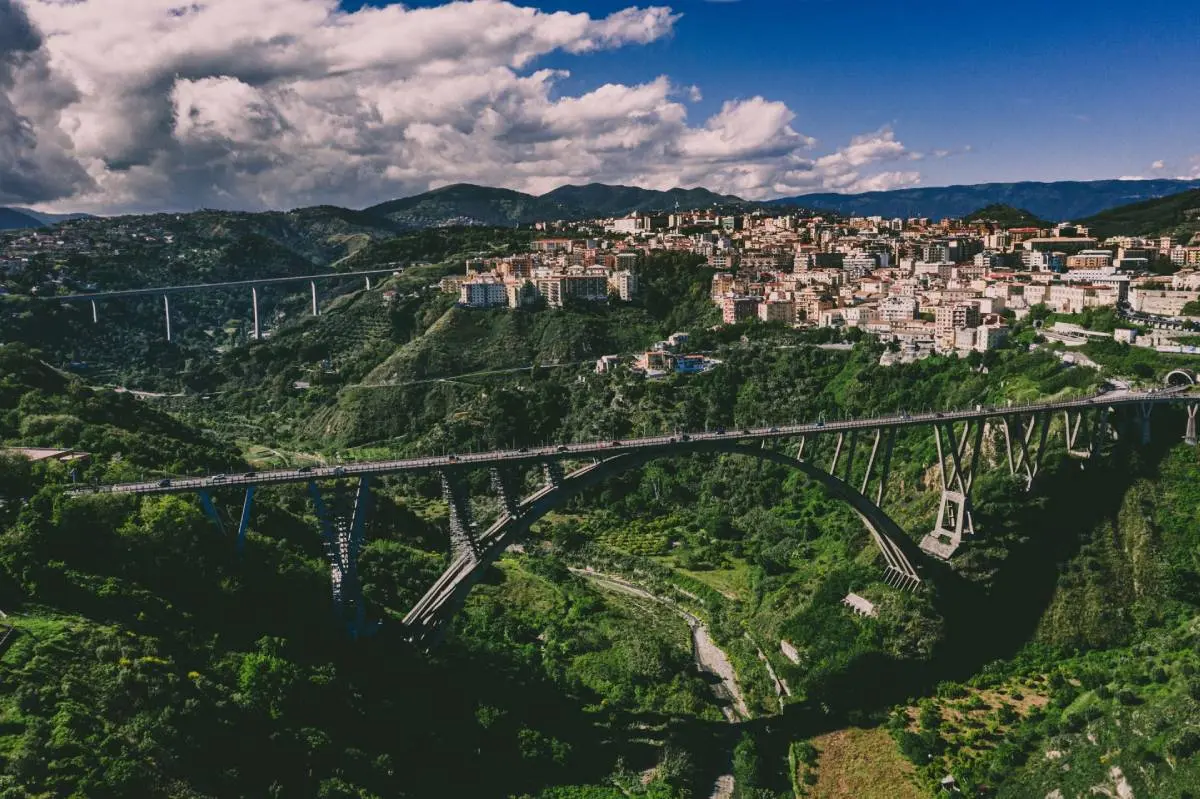Girifalco
Girifalco's mysterious Saurus

Town
The town of Girifalco is situated at the foot of Monte Covello, between the Gulf of Squillace and St Euphemia and in the middle of the Catanzaro isthmus, the narrowest point of the Italian peninsula.
Girifalco originated following the destruction of two ancient villages named Toco and Caria during the Saracen raids in 836. People from the villages took refuge on a cliff called "Pietra dei Monaci” (Stone of Monks).
The “Sauro di Girifalco” (Girifalco's saurus) is a mysterious sculpture that challenges all current knowledge on the dynamics of mankind's historical and cultural heritage.
The town probably owes its name to a falcon circling above a tower in the blue sky. Even if this may seem just like a myth, there may be some truth in it in view of the fact that the area of Girifalco constitutes during some periods of the year, a forced passage for these wonderful birds of prey during their migration. Girifalco is rich in monuments and places to visit, including: the church of S .Rocco dating back to the XVI century, a jewel of baroque architecture which houses the treasure of San Rocco (gift of the Duchess Margherita Caracciolo) as well as a magnificent wooden statue of the Saint; The Fontana “Carlo Pacino” ( Fountain of Carlo Pacino), a baroque monument recently restored to its ancient splendour, built in 1663 in honour of Girifalcon’s first mayor; the Chiesa dell’Annunziata (Church of the Annunciation) raised from the pavement, dating back to the XVIII century,which can be accessed by a stairway and was recently restored; the Chiesa di S. Maria delle Nevi (the main church or Church of Our Lady of Snow), built in the XVI century that underwent so many renovations during the 1950s that caused it to lose its old baroque façade; the Chiesa della Madonna del Rosario (Church of the Madonna of the Rosary), an 18th century construction, whose façade features an important portal; the Chiesa dell’Addolorata (Church of Our Lady of Sorrows), an 18th century building with with small three naves and an exterior that features an interesting Calvary with scenes depicting the life of Jesus Christ; the convent of the Friars Minor, built in 1650 at the request of Fabrizio Caracciolo, where according to some historians, Tommaso Campanella took refuge and was hidden by the friars. Following the suppression of the convent, in 1881 it became the Psychiatric Hospital, today known as the Complesso Monumentale (Monumental Complex); the Palazzo Ducale (Ducal Palace), now partially destroyed, built in the XVII century, inside preserves a Palatine altar. Not to be missed, in the mountains, is the statue of the “Madonnina di Monte Covello” where it is possible to enjoy delightful nature trails. A mountain sub-group of Monte Serralta, Monte Covello, with a height of 848 metres, it is also known for the diversity of its flora and wildlife. The area offers many nature trails, visited each year by many visitors, fascinated by the great outdoors. Major sources of mineral waters flow out from Monte Covello, in fact the abundance and the excellence of these waters have turned Girifalco into an important centre for bottling mineral water for the entire region.
Toloni-Azzariti Collection
This collection was the starting point of a series of studies that have brought its collector and later on various researchers, to suggest the theory that the area of Calabria where the items were found could have been an important Pelasgian civilisation settlement. The highlight of the Azzariti Toulon collection is the presence, among other items, of a small sculpture that challenges all current knowledge on the dynamics of mankind's historical and cultural heritage. The sculpture represents a dinosaur with its back full of plates, portraying a type of animal that does not seem to match any known species in the area of the discovery, at least not at the time of an evolved civilisation as that which produced the items which are part of the collection. The flood that affected the area of Girifalco in 1971, provoked large landslides and mudflows, encouraging the discovery of an anthropomorphic terracotta containing some engraved inscriptions with indecipherable characters. The discovery launched a subsequent search that proved quite successful, as evidenced by the hundreds of finds such as pebbles engraved with strange characters (petroglyphs), beautiful sculptures in limestone representing women with stylish hairstyles, engravings representing the cult to the sun, and the cult to trees, a splendid statue of calcareous stone representing a woman that is dragged by a large bull who turns his head back (quite similar to the one that can be found on coins of the ancient Sybaris). And in addition, terracotta figures with men on horseback, terracotta stelae with strange religious symbols, a very peculiar terracotta sphinx, terracotta bas-reliefs representing men with an emphasis on large phallic attributes. The list of discoveries includes weapons, such as stone spear heads stone, hatchets and chisels for sculpting stone, stone and terracotta funerary urns, eight epigraphs on a tablet that have not yet been deciphered. The collection’s main piece is represented by a terracotta statue of approximately 18 cm in length, depicting a strange saurus with triangular plates all along its back until its tail. The mystery concerns the fact that the animal portrayed in sculpture belongs to the species of stegosaurus; dinosaurs with plates that scientists say became extinct about 65 million years ago.
The Devil’s Fountain
Girifalco has many secrets that can be traced back to ancient myths. Right in the old town and clearly visible is the refined “fontana barocca” (Baroque fountain), one of the town’s most fascinating points of interest. Also known as the “Fontana di Carlo Pacino”, it was built during the XVII century next to the church consecrated to St Rocco, the town’s patron saint. Immediately, a common belief that then became a myth or legend, began to spread around that monument that, only a few steps from the Church, seemed to be turning its back to it. In fact, based on collective imagination, the great fountain was built by the devil in a single night, in order to display the prodigy of his powers and creativity, as if wanting to create a barrier with his presence between man and God. Many were the elements that led to corroborate this theory: the shape of a goat’s leg that clearly stands out from all other imperfections on the surface of the sandstone from which the monument is made; the three steps, located on all sides of a perfect octagonal structure; acacia branches, perfect hypnotising swirls as well as the symbolic masks. The fountain was the work of master stonecutters, skilful and envied Master of Art, capable of building their wonderful works in little time. It was precisely the speed with which the fountain was built that suggest the idea of a demonic work. Legends apart, the beauty of a remarkable monument that has been admired for hundreds of years still remains in Girifalco's town centre.
The Monumental Complex
Girifalco's Mental Asylum, known as the Complesso Monumentale, built in Southern Italy following the one in Palermo and Aversa, emerged as a result of the gift of the building known as the Convento dei Riformati (Convent of the Reformed), made by the town of Girifalco to the Provincial Administration. The purpose of the gift was to convert the convent into a building used to shelter people declared mentally unwell. Until the date of its closure, the Mental Asylum housed numerous patients suffering from various diseases which came from many parts of Italy and worldwide. The repressive effects of the true mental asylum often inspired creative activities of an artistic nature. This has led to an abundance of poetic and artistic works as a direct representation of that painful reality.
Useful information
What to know about Girifalco
Events
There are 2 events scheduled.
Where to Sleep
There are 1 available accommodations.
Infopoint Girifalco
Piazza Umberto I, 1, Girifalco
No result








